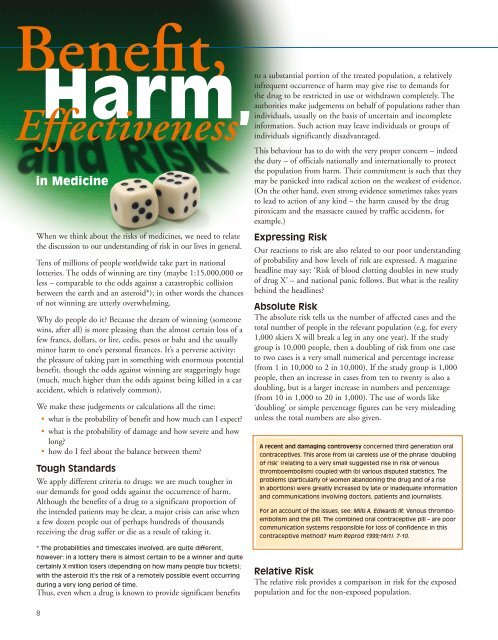Viewpoint Parts 1 - Uppsala Monitoring Centre
Viewpoint Parts 1 - Uppsala Monitoring Centre
Viewpoint Parts 1 - Uppsala Monitoring Centre
- No tags were found...
Create successful ePaper yourself
Turn your PDF publications into a flip-book with our unique Google optimized e-Paper software.
Benefit,Harm,Effectivenessin MedicineWhen we think about the risks of medicines, we need to relatethe discussion to our understanding of risk in our lives in general.Tens of millions of people worldwide take part in nationallotteries. The odds of winning are tiny (maybe 1:15,000,000 orless – comparable to the odds against a catastrophic collisionbetween the earth and an asteroid*); in other words the chancesof not winning are utterly overwhelming.Why do people do it? Because the dream of winning (someonewins, after all) is more pleasing than the almost certain loss of afew francs, dollars, or lire, cedis, pesos or baht and the usuallyminor harm to one’s personal finances. It’s a perverse activity:the pleasure of taking part in something with enormous potentialbenefit, though the odds against winning are staggeringly huge(much, much higher than the odds against being killed in a caraccident, which is relatively common).We make these judgements or calculations all the time:• what is the probability of benefit and how much can I expect?• what is the probability of damage and how severe and howlong?• how do I feel about the balance between them?Tough StandardsWe apply different criteria to drugs: we are much tougher inour demands for good odds against the occurrence of harm.Although the benefits of a drug to a significant proportion ofthe intended patients may be clear, a major crisis can arise whena few dozen people out of perhaps hundreds of thousandsreceiving the drug suffer or die as a result of taking it.to a substantial portion of the treated population, a relativelyinfrequent occurrence of harm may give rise to demands forthe drug to be restricted in use or withdrawn completely. Theauthorities make judgements on behalf of populations rather thanindividuals, usually on the basis of uncertain and incompleteinformation. Such action may leave individuals or groups ofindividuals significantly disadvantaged.This behaviour has to do with the very proper concern – indeedthe duty – of officials nationally and internationally to protectthe population from harm. Their commitment is such that theymay be panicked into radical action on the weakest of evidence.(On the other hand, even strong evidence sometimes takes yearsto lead to action of any kind – the harm caused by the drugpiroxicam and the massacre caused by traffic accidents, forexample.)Expressing RiskOur reactions to risk are also related to our poor understandingof probability and how levels of risk are expressed. A magazineheadline may say: ‘Risk of blood clotting doubles in new studyof drug X’ – and national panic follows. But what is the realitybehind the headlines?Absolute RiskThe absolute risk tells us the number of affected cases and thetotal number of people in the relevant population (e.g. for every1,000 skiers X will break a leg in any one year). If the studygroup is 10,000 people, then a doubling of risk from one caseto two cases is a very small numerical and percentage increase(from 1 in 10,000 to 2 in 10,000). If the study group is 1,000people, then an increase in cases from ten to twenty is also adoubling, but is a larger increase in numbers and percentage(from 10 in 1,000 to 20 in 1,000). The use of words like‘doubling’ or simple percentage figures can be very misleadingunless the total numbers are also given.A recent and damaging controversy concerned third generation oralcontraceptives. This arose from (a) careless use of the phrase ‘doublingof risk’ (relating to a very small suggested rise in risk of venousthromboembolism) coupled with (b) various disputed statistics. Theproblems (particularly of women abandoning the drug and of a risein abortions) were greatly increased by late or inadequate informationand communications involving doctors, patients and journalists.For an account of the issues, see: Mills A, Edwards IR. Venous thromboembolismand the pill. The combined oral contraceptive pill – are poorcommunication systems responsible for loss of confidence in thiscontraceptive method? Hum Reprod 1999;14(1). 7-10.* The probabilities and timescales involved, are quite different,however: in a lottery there is almost certain to be a winner and quitecertainly X million losers (depending on how many people buy tickets);with the asteroid it’s the risk of a remotely possible event occurringduring a very long period of time.Thus, even when a drug is known to provide significant benefitsRelative RiskThe relative risk provides a comparison in risk for the exposedpopulation and for the non-exposed population.8
















